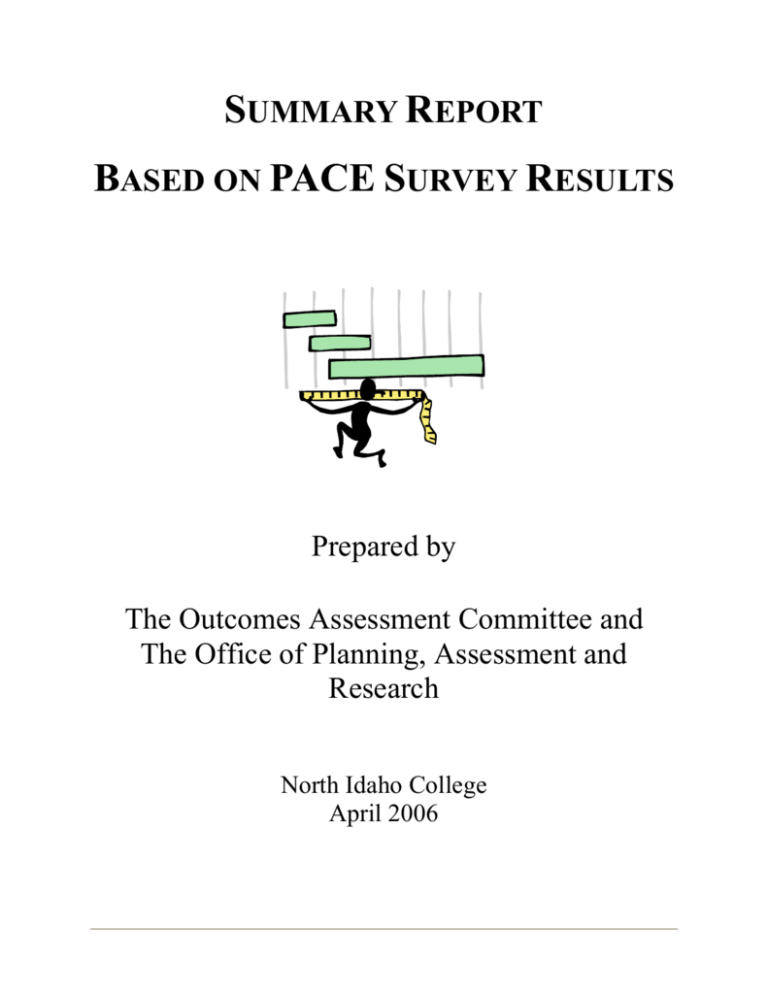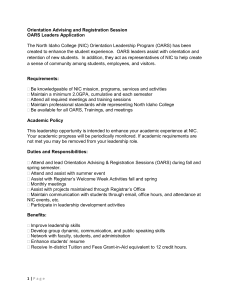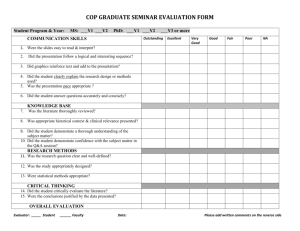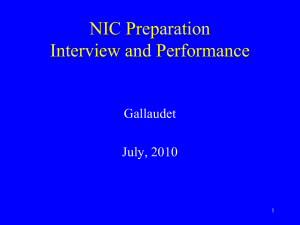SUMMARY REPORT BASED ON PACE SURVEY RESULTS
advertisement

SUMMARY REPORT BASED ON PACE SURVEY RESULTS Prepared by The Outcomes Assessment Committee and The Office of Planning, Assessment and Research North Idaho College April 2006 MEMORANDUM TO: The College Community FROM: Kathy Christie, Assistant Vice-President for Planning, Assessment and Research RE: Results from the PACE Survey (Personal Assessment of the College Environment) Survey DATE: April 10, 2006 The results from the PACE Survey were recently returned to North Idaho College by the survey publisher. A work group from the Outcomes Assessment Committee and the Office of Planning, Assessment and Research reviewed the results and prepared a summary report that includes key pages from the full report. The overall results of the survey were very positive. In fact, the survey publisher reported: • • • NIC’s overall results from the PACE survey indicate a healthy climate NIC’s overall scores exceeded the publisher’s norm base in all but one category NIC ranked in the consultative range as an institution Please note that the survey was given to 644 employees including all full-time employees and permanent, part-time employees. Temporary help employees and student employees were not surveyed. Of the 644 employees that were surveyed, 319 or 49.5% completed and returned the survey. On page five of the summary report, it shows the percentage of surveys returned by each employee subgroup. (Changes shown on the chart were added for clarification by NIC’s Office of Planning, Assessment and Research.) The survey publisher emphasized that “caution should be used when making inferences from the data, particularly for subgroups with return rates of less than 60%”. Note that the full-time classified employee group, the part-time classified employee group, and the part-time faculty group had less than a 60% return rate. If you have questions about the PACE Survey, please feel free to call Kathy Christie at 7693401. Both the summary report and the full survey report are available on the Planning, Assessment, and Research website at http://www.nic.edu/planning/survey EXECUTIVE SUMMARY In November, 2005, the Personal Assessment of the College Environment (PACE) survey was administered to 644 employees at North Idaho College (NIC). Of those 644 employees, 319 (49.5%) completed and returned the instrument for analysis. The purpose of the survey was to obtain the perceptions of personnel concerning the college climate and to provide data to assist NIC in promoting more open and constructive communication among faculty, staff, and administrators. Researchers at the National Initiative for Leadership and Institutional Effectiveness (NILIE) and representatives of NIC collaborated to administer a survey that would capture the opinions of personnel throughout the college. In the PACE model, the leadership of an institution motivates the Institutional Structure, Supervisory Relationships, Teamwork, and Student Focus climate factors toward an outcome of student success and institutional effectiveness. Figure 1. The PACE Model Climate Factors Institutional Structure Driver Supervisory Relationships Leadership Outcome Student Success Student Focus Teamwork NILIE has synthesized from the literature four leadership or organizational systems ranging from coercive to collaborative. According to Likert (1967), the Collaborative System, which he termed System 4, generally produced better results in terms of productivity, job satisfaction, communication, and overall organizational climate. The other systems were Consultative (System 3), Competitive (System 2) and Coercive (System 1). In agreement with Likert, NILIE has concluded that Collaborative (System 4) is the climate to be sought as opposed to existing naturally in the environment. Likert discovered that most of the organizations he studied functioned at the Competitive or Consultative levels. This has been NILIE's experience as well, with most college climates falling into the Consultative system across the four factors of the climate instrument. Of the more than 120 studies completed by NILIE, few institutions have been found to achieve a fully Collaborative (System 4) environment, although scores in some categories may fall in this range for some classifications of employees. Thus, if the Collaborative System is the ideal, then this environment is the one to be sought through planning, collaboration, and organizational development. North Idaho College PACE - 1 NIC Summary Report - 1 Employees completed a 46-item PACE instrument organized into four climate factors as follows: Institutional Structure, Supervisory Relationships, Teamwork, and Student Focus. They also completed a Customized section designed specifically for North Idaho College. Respondents were asked to rate the four factors on a five-point Likert-type scale. The instrument was specifically designed to compare the existing climate at NIC to a range of four managerial systems found to exist in colleges and to a Norm Base of 45 community colleges across North America. The information generated from the instrument has been developed into a research report that can be used for planning and decision-making in order to improve the existing college climate. The PACE instrument administered at NIC included 56 total items. Respondents were asked to rate items on a five-point satisfaction scale from a low of “1” to a high of “5.” Of the 56 items, none fell within the least favorable category identified as the Coercive range (rated between 1 and 2). Seven fell within the Competitive range (rated between 2 and 3). Forty six fell within the Consultative range (rated between 3 and 4), and three composite ratings fell within the Collaborative range (rated between 4 and 5). At NIC, the overall results from the PACE instrument indicate a healthy campus climate, yielding an overall 3.58 mean score or high Consultative system. The Teamwork category received the highest mean score (3.86), whereas the Institutional Structure category received the lowest mean score (3.17). When respondents were classified according to functional role at NIC, the composite ratings were as follows: FT Administrative/Professional (3.59), PT Administrative/Professional (3.79), FT Classified (3.26), PT Classified (3.86), FT Faculty/credit (3.64) and PT Faculty/credit (3.83). Overall, the following have been identified as areas of excellence at North Idaho College.* • The extent to which I feel my job is relevant to this institution's mission, 4.30 • The extent to which my supervisor expresses confidence in my work, 4.18 • The extent to which students receive an excellent education at this institution, 4.03 • The extent to which this institution prepares students for further learning, 3.98 • The extent to which my supervisor is open to the ideas, opinions, and beliefs of everyone, 3.98 • The extent to which there is a spirit of cooperation within my work team, 3.96 • The extent to which faculty meet the needs of the students, 3.94 • The extent to which my work team provides an environment for free and open expression , 3.90 • The extent to which I am given the opportunity to be creative in my work, 3.90 • The extent to which there is an opportunity for all ideas to be exchanged within my work team, 3.87 *Customized questions were not included in this listing. North Idaho College PACE - 2 NIC Summary Report - 2 The following have been identified as areas in need of improvement at North Idaho College.* • The extent to which information is shared within this institution, 2.86 • The extent to which I am able to appropriately influence the direction of this institution, 2.91 • The extent to which decisions are made at the appropriate level at this institution, 2.96 • The extent to which I have the opportunity for advancement, 2.98 • The extent to which open and ethical communication is practiced at this institution, 3.00 • The extent to which this institution is appropriately organized, 3.02 • The extent to which a spirit of cooperation exists at this institution, 3.04 • The extent to which institutional teams use problem-solving techniques, 3.07 • The extent to which this institution has been successful in positively motivating my performance, 3.23 • The extent to which professional development and training opportunities are available, 3.29 Respondents were also given an opportunity to provide comments about the most favorable aspects and the least favorable aspects of NIC. The responses provide insight and anecdotal evidence that support the survey questions. *Customized questions were not included in this listing. North Idaho College PACE - 3 NIC Summary Report - 3 METHOD Population In November, 2005, the Personal Assessment of the College Environment (PACE) survey was administered to the staff, faculty, and administrators of North Idaho College. Of the 644 employees administered the instrument, 319 (49.5%) completed and returned the instrument for analysis. Of those 319 employees, 158 (49.5%) completed the open-ended comments section. The purpose of the survey was to obtain the perceptions of personnel concerning the college climate and to provide data to assist NIC in promoting more open and constructive communication among faculty, staff, and administrators. Researchers at the National Initiative for Leadership and Institutional Effectiveness (NILIE) and the Office of Planning, Assessment and Research of NIC collaborated to administer a survey that would capture the opinions of personnel throughout the college. The PACE surveys were distributed to employees of NIC via campus mail boxes on October 10, 2005 based on the September 30th payroll list. Employees were provided with envelopes and were informed of the collection deadline and locations. Completed surveys were returned to NILIE for analysis. The surveys were read by an optical scanner and data were analyzed using the statistical package SAS, version 9.1. Instrumentation The PACE instrument is divided into four climate factors: Institutional Structure, Supervisory Relationships, Teamwork, and Student Focus. A Customized section developed by North Idaho College was also included in the administration of the instrument. A total of 56 items were included in the PACE survey, as well as a series of questions ascertaining the demographic status of respondents. Respondents were asked to rate the various climate factors through their specific statements on a five-point scale from a low of “1” to a high of “5.” The mean scores for all items were obtained and compared. Items with lower scores were considered to be high priority issues for the institution. In this way, the areas in need of improvement were ranked in order of priority, thereby assisting in the process of developing plans to improve the overall performance of the institution. After completing the pre-printed survey items, respondents were given an opportunity to provide comments about the most favorable aspects of NIC and the least favorable aspects. The written reponses provide insight and anecdotal evidence to support the survey questions. North Idaho College PACE - 11 NIC Summary Report - 4 DATA ANALYSIS Data were analyzed in five ways. First, a descriptive analysis of the respondents’ demographics are presented, followed by an overall analysis of the item and climate factor means and standard deviations. Similar analyses were applied to the items and climate factors by functional role and generated priorities for change for each functional role. Also, comparative analyses of factor means by demographic variables were conducted. The item and domain means of this PACE were correspondingly compared with the NILIE Norm Base, with significant differences between means being identified through t-tests. Finally, a qualitative analysis was conducted on the open-ended comments provided by the survey respondents. Respondent Characteristics Of the 761 employees at NIC, 644 were administered the survey. Of those 644, 319 (49.5%) completed the PACE survey. Survey respondents classified themselves into functional roles. Refer to Table 3 and Figure 2. Table 3. Response by Self-Selected Functional Role Functional Role Surveys Distributed * Population Surveys Returned for Analysis Percent of Population Represented FT Adm./Prof 109 80 73.4% PT Adm./Prof. 23 14 60.9% FT Classified 172 71 41.3% PT Classified 163 46 * 15 9.2% 32.6% * FT Faculty/credit 153 94 61.4% PT Faculty/credit 141 33 23.4% Did not respond Total 12 761 644 * 319 41.9% 49.5% * Caution should be used when making inferences from the data, particularly for subgroups with return rates of less than 60%. * NOTE: Changes shown above were made for clarification by NIC’s Office of Planning, Assessment and Research North Idaho College PACE - 13 NIC Summary Report - 5 Table 4 reports the number of respondents across the different demographic classifications and the percentage of the overall responses that each group represents. Table 4. Proportion of Responses Across Demographic Classifications Demographic Variable What is your NIC personnel classification: FT Administrative/Professional PT Administrative/Professional FT Classified PT Classified FT Faculty/credit PT Faculty/credit Did not respond # of Responses % of Responses 80 14 71 15 94 33 12 25.1% 4.4% 22.3% 4.7% 29.5% 10.3% 3.8% What is your race/ethnicity: Caucasian Other Did not respond 288 22 9 90.3% 6.9% 2.8% What is your gender Female Male Did not respond 181 130 8 56.7% 40.8% 2.5% 28 86 90 36 66 13 8.8% 27.0% 28.2% 11.3% 21.0% 4.1% In which type of NIC Department are you employed: Administrative Departments Instructional Div or Instructional Support Dept Student Services Departments Technical Support Departments Physical Plant or Campus Services Departments Did not respond 36 174 48 20 26 15 11.3% 54.6% 15.1% 6.3% 8.2% 4.7% What is your residence by county: Kootenai Bonner Shoshone Boundary Benewah Other Did not respond 253 17 5 2 2 32 8 79.3% 5.3% 1.6% 0.6% 0.6% 10.0% 2.5% How long have you worked at this institution: Less than 1 year 1 - 4 years 5 - 9 years 10 - 14 years 15 or more years Did not respond North Idaho College PACE - 15 NIC Summary Report - 6 Table 4. Continued. Demographic Variable How active are you in your NIC employee organization: Very Active Moderately Active Occasionally Active Rarely Participate Never Participate Did not respond What type of NIC activities do you most often attend: Athletic Events Musical Events Theatre Performances College Forums College Social Activities Did not respond If you are part-time faculty member teaching credit classes, do you teach: five credits or more on a Letter of Appointment less than five credits on a Letter of Appointment Did not respond What is your county or country of residence: I am a resident of one of the five northern counties in Idaho I am a resident of another county in Idaho I am a resident of Spokane County in Washington I am a resident of another county in Washington other than Spokane County Did not respond North Idaho College PACE - 16 # of Responses % of Responses 37 71 81 65 48 17 11.6% 22.3% 25.4% 20.4% 15.0% 5.3% 45 42 80 54 34 64 14.1% 13.2% 25.1% 16.9% 10.7% 20.1% 34 11 274 10.7% 3.5% 85.9% 271 1 26 5 85.0% 0.3% 8.1% 1.6% 16 5.0% NIC Summary Report - 7 Comparative Analysis: Overall The results from the PACE survey indicate that personnel perceive the composite climate at NIC to fall toward the middle-range of the Consultative management style. The scale range describes the four systems of management style defined by Likert and adapted by Baker and the NILIE team in their previous in-depth case studies. The four systems are Coercive management style (i.e., a mean score rating between 1.0 and 2.0), Competitive management style (i.e., a mean score rating between 2.0 and 3.0), Consultative management style (i.e., a mean score rating between 3.0 and 4.0), and Collaborative management style (i.e., a mean score rating between 4.0 and 5.0). As previously stated, the Collaborative management style is related to greater productivity, group decision making, and the establishment of higher performance goals when compared to the other three styles. Thus, the Collaborative system is a system to be sought through planning and organizational learning. As indicated in Table 5, the Teamwork climate factor received the highest composite rating (3.86), which represented a high Consultative management environment. The Institutional Structure climate factor received the lowest mean score (3.17) within the low area of the Consultative management area. Overall, employees rated the management style in the middle range of the Consultative management area. (See also Figure 3). Table 5. North Idaho College Climate as Rated by All Employees Domain Supervisory Relationships Institutional Structure Teamwork Student Focus Customized Overall* NIC 3.68 3.17 3.86 3.82 3.33 3.58 * Overall does not include the customized section developed specifically for NIC. North Idaho College PACE - 17 NIC Summary Report - 8 Figure 3. North Idaho College Climate as Rated by All Employees Combined Using Composite Averages 5 Collaborative 4 Consultative 3 Competitive 2 Coercive 1 Supervisory Relationship Institutional structure Teamwork Student Focus Custom Overall In reviewing each of the items separately, the data shows that of the 56 mean scores, no items fell within the Coercive management style (i.e., a mean score rating between 1.0 and 2.0), seven fell within the Competitive management style (i.e., a mean score rating between 2.0 and 3.0). Forty-six fell within a Consultative management style (i.e., a mean score rating between 3.0 and 4.0) and three fell within a Collaborative management style (i.e., a mean score rating between 4.0 and 5.0). The preponderance of Consultative (n=46) scores indicates that the institution has a relatively high level of perceived productivity and satisfaction. Overall results from the survey yielded a mean institutional climate score of 3.58 as indicated on the previous page in Table 5. Tables 6 through 10 report the mean scores of all personnel for each of the 56 items included in the survey instrument. The mean scores and standard deviations presented in this table estimate what the personnel participating in the study at NIC perceive the climate to be at this particular time in the institution's development. The standard deviation (SD) demonstrates the variation in responses to a given question. For example, a small SD demonstrates that most answers fell within a narrow or restrictive range. Conversely, a large SD demonstrates that more variance existed around the mean score for the item. When the SD becomes too great, the mean is no longer a reliable indicator of the participant responses. Items which are new to the revised PACE cannot be compared to previous administrations using the old version. North Idaho College PACE - 18 NIC Summary Report - 9 Comparative Analysis: Functional Role Figure 4 and Table 11 report composite ratings according to the four climate factors and the customized questions for employees in functional roles. In general the part time faculty employees rated the four normative factors most favorable (3.89), whereas the full time classified employees rated the four normative factors least favorable (3.26). Figures 5 through 9 show the ratings of each employee group for each of the 56 climate items. The data summary for each figure precedes the corresponding figure. This information provides a closer look at the institutional climate ratings and should be examined carefully when prioritizing areas for change among the employee groups. Figure 4. Mean Climate Scores as Rated by Functional Roles at North Idaho College. 5 Collaborative 4 Consultative 3 Competitive FT Adm./Prof PT Adm./Prof. FT Classified PT Classified FT Faculty/credit PT Faculty/credit 2 Coercive 1 Supervisory Responsibility Institutional Structure Teamwork Student Focus Custom Overall Table 11. Mean Climate Scores as Rated by Functional Roles Supervisory Relationships Institutional Structure Teamwork Student Focus Custom Overall FT Adm./Prof 3.73 3.16 3.96 3.80 3.34 3.59 PT Adm./Prof. 4.00 3.43 4.23 3.70 3.15 3.79 FT Classified 3.31 2.89 3.45 3.59 3.23 3.26 PT Classified 4.00 3.55 4.01 3.94 3.67 3.89 FT Faculty/credit 3.74 3.14 3.96 3.97 3.30 3.64 PT Faculty/credit 3.87 3.57 3.97 4.06 3.56 3.83 Domain *The overall mean does not reflect the mean scores of the customized items developed specifically for NIC. North Idaho College PACE - 22 NIC Summary Report - 10 Tables 12 through 17 contain the top ten priorities for improvement for each functional role among the standard PACE items and the top three priorities for improvement from the customized items developed specifically for North Idaho College. Table 12. Priorities for Change: FT Administrative/Professional Mean 2.84 2.88 2.90 2.94 2.94 3.03 3.03 3.17 3.26 3.29 Mean 2.73 2.80 2.94 Area to Change The extent to which information is shared within this institution The extent to which a spirit of cooperation exists at this institution The extent to which decisions are made at the appropriate level The extent to which open and ethical communication is practiced The extent to which this institution is appropriately organized The extent to which institutional teams use problem-solving techniques The extent to which I am able to appropriately influence the direction of this institution The extent to which I have the opportunity for advancement The extent to which institution-wide policies guide my work The extent to which this institution has been successful in positively motivating my performance Area to Change—Customized The extent to which adjunct faculty feel they are included in the community The extent to which there is a positive relationship between faculty/staff/administration The extent to which institutional procedures and policies are broadly communicated Table 13. Priorities for Change: PT Administrative/Professional Mean 3.00 3.07 3.08 3.17 3.17 3.25 3.36 3.36 3.36 3.46 Mean 2.54 2.85 3.00 Area to Change The extent to which this institution is appropriately organized The extent to which information is shared within this institution The extent to which decisions are made at the appropriate level The extent to which institutional teams use problem-solving techniques The extent to which I am able to appropriately influence the direction of this institution The extent to which classified (supporting) personnel meet the needs of the students The extent to which administrative leadership is focused on meeting the needs of students The extent to which a spirit of cooperation exists at this institution The extent to which institution-wide policies guide my work The extent to which this institution has been successful in positively motivating my performance Area to Change—Customized The extent to which the institution has made progress on paying competitive salaries The extent to which the work-site meets occupational, safety, and health standards (e.g. air quality, ergonomics) The extent to which the institution's offices are service-friendly to students North Idaho College PACE - 28 NIC Summary Report - 11 Table 14. Mean 2.41 2.50 2.62 2.64 2.66 2.71 2.79 2.86 3.00 3.00 Mean 2.64 2.77 2.85 Priorities for Change: FT Classified Area to Change The extent to which I have the opportunity for advancement The extent to which information is shared within this institution The extent to which open and ethical communication is practiced The extent to which decisions are made at the appropriate level The extent to which I am able to appropriately influence the direction of this institution The extent to which a spirit of cooperation exists at this institution The extent to which this institution is appropriately organized The extent to which institutional teams use problem-solving techniques The extent to which this institution has been successful in positively motivating my performance The extent to which work outcomes are clarified for me Area to Change—Customized The extent to which the institution has made progress on paying competitive salaries The extent to which institutional procedures and policies are broadly communicated The extent to which there is a positive relationship between faculty/staff/administration Table 15. Priorities for Change: PT Classified Mean 3.07 3.46 3.50 3.50 3.50 3.53 3.57 3.57 3.57 3.60 Mean 3.07 3.36 3.46 Area to Change The extent to which I have the opportunity for advancement The extent to which professional development and training opportunities are available The extent to which decisions are made at the appropriate level The extent to which I am able to appropriately influence the direction of this institution The extent to which institution-wide policies guide my work The extent to which my work is guided by clearly defined administrative processes The extent to which information is shared within this institution The extent to which work outcomes are clarified for me The extent to which this institution is appropriately organized The extent to which open and ethical communication is practiced Area to Change—Customized The extent to which this institution provides a comprehensive employee benefits package (e.g., medical, leave, flexible) The extent to which the institution has made progress on paying competitive salaries The extent to which this institution has a fair Employee Recognition and Awards Program North Idaho College PACE - 29 NIC Summary Report - 12 Table 16. Mean 2.77 2.79 2.89 2.95 2.95 2.97 3.02 3.15 3.19 3.20 Mean 2.68 2.69 2.87 Priorities for Change: FT Faculty/credit Area to Change The extent to which I am able to appropriately influence the direction of this institution The extent to which information is shared within this institution The extent to which open and ethical communication is practiced The extent to which decisions are made at the appropriate level The extent to which this institution is appropriately organized The extent to which a spirit of cooperation exists at this institution The extent to which institutional teams use problem-solving techniques The extent to which this institution has been successful in positively motivating my performance The extent to which I have the opportunity for advancement The extent to which my work is guided by clearly defined administrative processes Area to Change—Customized The extent to which adjunct faculty feel they are included in the community The extent to which the institution has made progress on paying competitive salaries The extent to which there is a positive relationship between faculty/staff/administration Table 17. Priorities for Change: PT Faculty/credit Mean 2.78 3.16 3.41 3.43 3.50 3.52 3.58 3.58 3.59 3.59 Mean 2.88 3.08 3.19 Area to Change The extent to which I have the opportunity for advancement The extent to which I am able to appropriately influence the direction of this institution The extent to which information is shared within this institution The extent to which institutional teams use problem-solving techniques The extent to which this institution has been successful in positively motivating my performance The extent to which professional development and training opportunities are available The extent to which institution-wide policies guide my work The extent to which my work is guided by clearly defined administrative processes The extent to which decisions are made at the appropriate level The extent to which my supervisor actively seeks my ideas Area to Change—Customized The extent to which the institution has made progress on paying competitive salaries The extent to which this institution provides a comprehensive employee benefits package (e.g., medical, leave, flexible) The extent to which adjunct faculty feel they are included in the community North Idaho College PACE - 30 NIC Summary Report - 13 Comparative Analysis: Norm Base Table 19 shows how NIC compares with the NILIE PACE Norm Base, which includes climate studies from approximately 45 different institutions, conducted at two-year institutions since 2003. These studies include small, medium, and large institutions. Institutions range in size from 1,200 credit students on one campus to 22,000 credit students enrolled on multiple campuses. The Norm Base is updated each year to include the prior 2-year period. Normative data are not available for the Customized climate factor area developed specifically for NIC. Figure 10 also shows how NIC compares with data from the four PACE climate factors (i.e., Institutional Structure, Supervisory Relationships, Teamwork, and Student Focus) maintained by NILIE. Table 19. North Idaho College Climate compared with the NILIE PACE Norm Base NIC Norm Base* Supervisory Relationships 3.68 3.62 Institutional Structure 3.17 3.31 Teamwork 3.86 3.67 Student Focus 3.82 3.80 Overall 3.56 3.57 Figure 10. North Idaho College Climate Compared with the NILIE PACE Norm Base 5 Collaborative 4 Consultative 3 Competitive 2 2005 PACE Coercive Norm Base 1 Supervisory Relationship Institutional structure Teamwork Student Focus Overall *Normative data are not available for the customized climate factor developed specifically for NIC. Thus, the customized items are not included in the calculation of the overall mean. North Idaho College PACE - 32 NIC Summary Report - 14 Conclusion One of the primary purposes of the PACE instrument is to provide insight that will assist in efforts to improve the climate at an institution or system of institutions. To accomplish this goal, the mean scores for each of the items were arranged in ascending order, from the lowest to the highest values. The distance between each item mean and the ideal situation, represented by a score of 4.50 on any item, can be identified as a measure of the extent to which individuals and groups can be motivated through leadership to improve the climate within the institution. Thus, the gap between the scores on what is and what could be for each item is the zone of possible change within the institution. Those items with the highest values are viewed as areas of satisfaction or excellence within the climate. Conversely, those items with the lowest values are the areas of least satisfaction or in need of improvement. Overall the following have been identified as areas of excellence at North Idaho College. Two of these items represent the Institutional Structure climate factor (items #2 and #39), five of these items represent the Teamwork climate factor (items #8, #9, #17, #31, and #37), and three of these items represent the Student Focus climate factor (items #3, #24, and #33). • The extent to which I feel my job is relevant to this institution's mission, 4.30 (#8) • The extent to which my supervisor expresses confidence in my work, 4.18 (#2) • The extent to which students receive an excellent education at this institution, 4.03 (#31) • The extent to which this institution prepares students for further learning, 3.98 (#37) • The extent to which my supervisor is open to the ideas, opinions, and beliefs of everyone, 3.98 (#9) • The extent to which there is a spirit of cooperation within my work team, 3.96 (#3) • The extent to which faculty meet the needs of the students, 3.94 (#17) • The extent to which my work team provides an environment for free and open expression of ideas, opinions and beliefs, 3.90 (#33) • The extent to which I am given the opportunity to be creative in my work, 3.90 (#39) • The extent to which there is an opportunity for all ideas to be exchanged within my work team, 3.87 (#24) Overall the following have been identified as the top three areas of excellence within the Customized Climate factor at North Idaho College. • The extent to which this institution maintains confidentiality of information pertaining to me, 3.83 (#49) • The extent to which campus security provides for my safety, 3.74 (#47) • The extent to which this institution provides a comprehensive employee benefits package (e.g., medical, leave, flexible), 3.58 (#51) North Idaho College PACE - 53 NIC Summary Report - 15 The following have been identified as areas in need of improvement at North Idaho College. All of these items represent the Institutional Structure climate factor. • The extent to which information is shared within this institution, 2.86 (#10) • The extent to which I am able to appropriately influence the direction of this institution, 2.91 (#15) • The extent to which decisions are made at the appropriate level at this institution, 2.96 (#4) • The extent to which I have the opportunity for advancement, 2.98 (#38) • The extent to which open and ethical communication is practiced at this institution, 3.00 (#16) • The extent to which this institution is appropriately organized, 3.02 (#32) • The extent to which a spirit of cooperation exists at this institution, 3.04 (#25) • The extent to which institutional teams use problem-solving techniques, 3.07 (#11) • The extent to which this institution has been successful in positively motivating my performance, 3.23 (#22) • The extent to which professional development and training opportunities are available, 3.29 (#46) Overall the following have been identified as the top three areas in need of improvement within the Customized Climate factor at North Idaho College. • The extent to which the institution has made progress on paying competitive salaries, 2.84 (#53) • The extent to which adjunct faculty feel they are included in the community, 2.87 (#56) • The extent to which there is a positive relationship between faculty/staff/administration, 2.99 (#55) The largest number of least favorable comments of North Idaho College represented in the qualitative section of the PACE survey were from the Institutional Structure climate factor. This is also the factor with the most suggestions for improvement reflected in the ten lowest mean scores in the survey. While there are many employees at NIC who enjoy the community atmosphere, there seems to be an underlying tension between those administrators who are making decisions for the college, and the role of faculty and staff in the day to day operations of the college. North Idaho College PACE - 54 NIC Summary Report - 16







